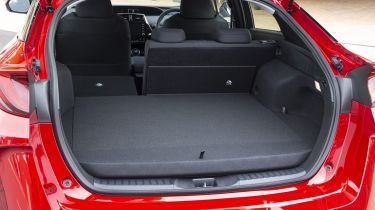Toyota Prius Plug-In (2016-2022) boot space & seating
A bigger battery pack in Toyota Prius Plug-in Hybrid hampers boot space, but it's thankfully now available as a five-seater
| Length | Width | Height | Boot volume |
|---|---|---|---|
| 4,645mm | 1,760mm | 1,470mm | 360 litres |
In the move from regular hybrid to plug-in, the Toyota Prius Plug-in lost some of its usability, a factor that makes the standard car such a brilliantly affordable and efficient package – but it’s still worth considering, especially now it comes with five seats.
Toyota Prius Plug-In interior space, storage & comfort
The Toyota Prius Plug-in Hybrid is just as practical in the front seats as its regular hybrid sibling, with plenty of room and good visibility. Those centrally mounted instruments mean there’s no binnacle in front of you, so visibility is good. This is helped by the relatively low dashboard.
The front of the interior is functional, too. There’s a pair of cup-holders, a tray to store your phone or wallet (this is where the wireless charging pad is located if fitted) and the lack of a transmission tunnel means the front of the interior feels relatively roomy.
At launch, the Prius Plug-In was only available as a four-seater, with two seats in the rear. There was a good amount of leg and headroom in the rear for back-seat passengers, but it restricted the practicality of the Plug-In compared to the regular Prius or Hyundai Ioniq Plug-In. An update in 2019 saw all Prius Plug-Ins delivered since then come with three rear seats.
Boot space
The bigger battery the Prius Plug-In uses compared to the regular Prius does eat into the boot space, so there’s only 191 litres of luggage room. The battery means the boot floor is quite high, so at least it’s easy to lift bags into the boot.
Fold the rear seats down and this figure increases to 1,204 litres – in both configurations it’s quite some way behind the level of practicality the Ioniq Plug-In serves up. At least there's a little flap in the boot near the bumper where you can stow the charging cables, so they don’t eat into boot space any more and compromises practicality any further in this already flawed plug-in model.




